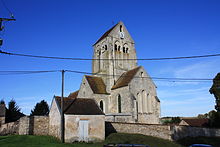Cierges
| Cierges | ||
|---|---|---|

|
|
|
| region | Hauts-de-France | |
| Department | Aisne | |
| Arrondissement | Château-Thierry | |
| Canton | Fère-en-Tardenois | |
| Community association | Region de Château-Thierry | |
| Coordinates | 49 ° 10 ′ N , 3 ° 36 ′ E | |
| height | 133-226 m | |
| surface | 8.22 km 2 | |
| Residents | 66 (January 1, 2017) | |
| Population density | 8 inhabitants / km 2 | |
| Post Code | 02130 | |
| INSEE code | 02193 | |
Cierges is a French municipality with 66 inhabitants (at January 1, 2017) in the department of Aisne in the region of Hauts-de-France . It belongs to the arrondissement of Château-Thierry , the canton of Fère-en-Tardenois and the municipal association of the Région de Château-Thierry .
geography
Cierges is located in the southwest of the Picardy region on the plateau of Tardenois in the Omois , 33 kilometers southwest of Reims and 6.9 kilometers southeast of Fère-en-Tardenois , between Sergy in the northwest and Ronchères in the south. The Ourcq flows through the municipality. To the southwest of the municipality is a large forest called Bois Meunière .
history
In 1154 Cierges was first mentioned as Cirgis in the copial book of the Saint-Yved monastery . In 1234 it was mentioned as Cierge in the copial book of the Abbaye Notre-Dame d'Igny in Arcis-le-Ponsart . In 1383 it was mentioned in Vermandois documents as the Sierges . Melleville wrote in his Dictionnaire historique du département de l'Aisne that the place name is derived from the Middle Latin word cerchia , "circle". In modern French , Cierges means "candles".
In the 16th and 17th centuries Cierges was fiefdom of the du Houx family , in the 18th century, until the French Revolution (1789–1799), it came into the possession of the Barons of Fruges through marriage .
Population development
| year | 1962 | 1968 | 1975 | 1982 | 1990 | 1999 | 2007 | 2016 |
| Residents | 122 | 111 | 121 | 78 | 81 | 62 | 74 | 68 |
Attractions
The Dolmen of Carauda dates from the Neolithic period . It was classified as a Monument historique (historical monument) as early as 1889 .
Notre-Dame church was built in the 12th century and enlarged in the 13th century. It was classified as a Monument historique in 1920. Photos from 1920 show that it was damaged at the time, probably as a result of the First World War . In the church there are two other monuments historiques, an altarpiece from 1667 and a picture on the lambris of the choir depicting the apostles and arabesques .
Web links
Individual evidence
- ↑ Cierges on annuaire-mairie.fr (French). Retrieved December 12, 2009
- ^ Cierges in Base Mérimée (French). Retrieved December 12, 2009
- ^ Cierges in Base Mémoire (French) Retrieved December 12, 2009
- ↑ Cierges in Base Palissy (French) Retrieved December 12, 2009

